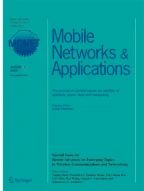Abstract
With the popularization of social networks, increasing numbers of users choose to use Weibo to get information. However, as the number of users grows, the information on Weibo is also multiplying, making it increasingly difficult for users to find the right information they are interested in. Therefore, how to recommend high-quality friends to follow the Weibo is one of the focuses of studies in Weibo-based personalized services. Based on existing Weibo social networking topologies and content-based hybrid recommendation algorithms, the study proposed a hybrid recommendation algorithm based on social relations and time-sequenced topics, which has been verified using Real Sina Weibo datasets. The results show that the improved hybrid recommendation algorithm works well and achieves better mean average precision (MAP) than existing other counterparts.
Similar content being viewed by others
References
Fortino G, Garro A, Russo W (2008) Achieving mobile agent systems interoperability through software layering. Inf Softw Technol 50(4):322–341
Fortino G, Russo W (2008) Using p2p, grid and agent technologies for the development of content distribution networks. Futur Gener Comput Syst 24(3):180–190
Di Fatta G, Blasa F, Cafiero S, Fortino G (2013) Fault tolerant decentralised k-means clustering for asynchronous large-scale networks. J Parallel Distrib Comput 73(3):317–329
Wang Z, Tan Y, Zhang M (2010) Graph-based recommendation on social networks. In: 2010 12th International Asia-Pacific on web conference (APWEB). IEEE, pp 116–122
Naruchitparames J, Güneṡ MH, Louis SJ (2011) Friend recommendations in social networks using genetic algorithms and network topology. In: 2011 IEEE congress of evolutionary computation (CEC). IEEE, pp 2207–2214
Akbari F, Tajfar A H, Nejad AF (2013) Graph-based friend recommendation in social networks using artificial bee colony. In: 2013 IEEE 11th international conference on dependable, autonomic and secure computing (DASC). IEEE, pp 464–468
Wu W, Zhang B, Ostendorf M (2010) Automatic generation of personalized annotation tags for twitter users. In: Human language technologies: the 2010 annual conference of the North American chapter of the association for computational linguistics. Association for Computational Linguistics, pp 689–692
Tang J, Fang Z, Sun J (2015) Incorporating social context and domain knowledge for entity recognition. In: Proceedings of the 24th international conference on World Wide Web. ACM, pp 517–526
Chen J, Geyer W, Dugan C, Muller M, Guy I (2009) Make new friends, but keep the old: recommending people on social networking sites. In: Proceedings of the SIGCHI conference on human factors in computing systems. ACM, pp 201–210
Agarwal V, Bharadwaj K (2013) A collaborative filtering framework for friends recommendation in social networks based on interaction intensity and adaptive user similarity. Soc Netw Anal Min 3(3):359–379
Chen T, Tang L, Liu Q, Yang D, Xie S, Cao X, Wu C, Yao E, Liu Z, Jiang Z et al (2012) Combining factorization model and additive forest for collaborative followee recommendation. In: KDD CUP
Yu Y, Qiu R G (2014) Followee recommendation in microblog using matrix factorization model with structural regularization. Sci World J 2014:
Armentano M G, Godoy D, Amandi A (2012) Topology-based recommendation of users in micro-blogging communities. J Comput Sci Technol 27(3):624–634
Acknowledgements
This work is supported by China National Natural Science Foundation under Grant 61602519.
Author information
Authors and Affiliations
Corresponding author
Rights and permissions
About this article
Cite this article
Zhang, Y., Tu, Z. & Wang, Q. TempoRec: Temporal-Topic Based Recommender for Social Network Services. Mobile Netw Appl 22, 1182–1191 (2017). https://doi.org/10.1007/s11036-017-0864-3
Published:
Issue Date:
DOI: https://doi.org/10.1007/s11036-017-0864-3
